
In chemistry, a salt is an ionic compound that can be formed by the neutralization reaction of an acid and a base. Salts are composed of related numbers of cations and anions so that the product is electrically neutral. These component ions can be inorganic, such as chloride (Cl−), or organic, such as acetate ; and can be monatomic, such as fluoride (F−), or polyatomic, such as sulfate.
Benedict's reagent is a chemical reagent named after American chemist Stanley Rossiter Benedict.

Basic copper carbonate is a chemical compound, more properly called copper(II) carbonate hydroxide. It is an ionic compound consisting of the ions copper(II) Cu2+
, carbonate CO2−
3, and hydroxide HO−
.

Magnesium sulfate is an inorganic salt with the formula MgSO4(H2O)x where 0≤x≤7. It is often encountered as the heptahydrate sulfate mineral epsomite (MgSO4·7H2O), commonly called Epsom salt. The overall global annual usage in the mid-1970s of the monohydrate was 2.3 million tons, of which the majority was used in agriculture.

Manganese(IV) oxide is the inorganic compound with the formula MnO
2. This blackish or brown solid occurs naturally as the mineral pyrolusite, which is the main ore of manganese and a component of manganese nodules. The principal use for MnO
2 is for dry-cell batteries, such as the alkaline battery and the zinc-carbon battery. MnO
2 is also used as a pigment and as a precursor to other manganese compounds, such as KMnO
4. It is used as a reagent in organic synthesis, for example, for the oxidation of allylic alcohols. MnO
2 in the α polymorph can incorporate a variety of atoms in the "tunnels" or "channels" between the manganese oxide octahedra. There is considerable interest in α-MnO
2 as a possible cathode for lithium ion batteries.
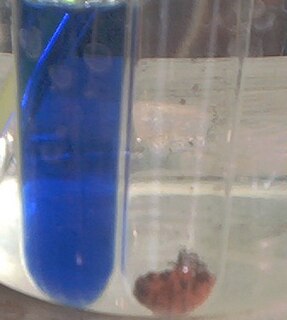
Fehling's solution is a chemical reagent used to differentiate between water-soluble carbohydrate and ketone functional groups, and as a test for reducing sugars and non-reducing sugars, supplementary to the Tollens' reagent test. The test was developed by German chemist Hermann von Fehling in 1849.
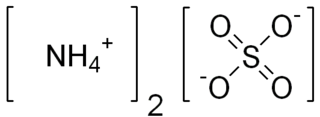
Ammonium sulfate (American English and international scientific usage; ammonium sulphate in British English); (NH4)2SO4, is an inorganic salt with a number of commercial uses. The most common use is as a soil fertilizer. It contains 21% nitrogen and 24% sulfur.

Tetraamminecopper(II) sulfate is the inorganic compound with the formula [Cu(NH3)4(H2O)n]SO4. This dark blue solid is a metal complex with faint odour of ammonia. It is closely related to Schweizer's reagent, which is used for the production of cellulose fibers in the production of rayon. It is used to print fabrics, used as a pesticide and to make other copper compounds like copper nano-powder.

Copper(II) hydroxide is the hydroxide of copper with the chemical formula of Cu(OH)2. It is a pale greenish blue or bluish green solid. Some forms of copper(II) hydroxide are sold as "stabilized" copper hydroxide, although they likely consist of a mixture of copper(II) carbonate and hydroxide. Copper hydroxide is a weak base.
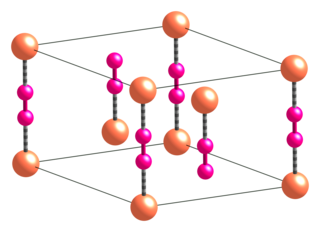
Copper(I) cyanide is an inorganic compound with the formula CuCN. This off-white solid occurs in two polymorphs; impure samples can be green due to the presence of Cu(II) impurities. The compound is useful as a catalyst, in electroplating copper, and as a reagent in the preparation of nitriles.
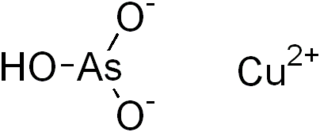
Scheele's Green, also called Schloss Green, is chemically a cupric hydrogen arsenite, CuHAsO
3. It is chemically related to Paris Green. It is a yellowish-green pigment which in the past was used in some paints, but has since fallen out of use because of its toxicity and the instability of its color in the presence of sulfides and various chemical pollutants.
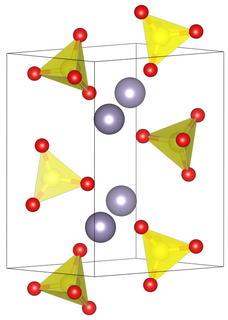
Tin(II) sulfate (SnSO4) is a chemical compound. It is a white solid that can absorb enough moisture from the air to become fully dissolved, forming an aqueous solution; this property is known as deliquescence. It can be prepared by a displacement reaction between metallic tin and copper(II) sulfate:
In ore deposit geology, supergene processes or enrichment are those that occur relatively near the surface as opposed to deep hypogene processes. Supergene processes include the predominance of meteoric water circulation with concomitant oxidation and chemical weathering. The descending meteoric waters oxidize the primary (hypogene) sulfide ore minerals and redistribute the metallic ore elements. Supergene enrichment occurs at the base of the oxidized portion of an ore deposit. Metals that have been leached from the oxidized ore are carried downward by percolating groundwater, and react with hypogene sulfides at the supergene-hypogene boundary. The reaction produces secondary sulfides with metal contents higher than those of the primary ore. This is particularly noted in copper ore deposits where the copper sulfide minerals chalcocite Cu2S, covellite CuS, digenite Cu1.8S, and djurleite Cu31S16 are deposited by the descending surface waters.

Alkali, or Alkaline, soils are clay soils with high pH, a poor soil structure and a low infiltration capacity. Often they have a hard calcareous layer at 0.5 to 1 metre depth. Alkali soils owe their unfavorable physico-chemical properties mainly to the dominating presence of sodium carbonate, which causes the soil to swell and difficult to clarify/settle. They derive their name from the alkali metal group of elements, to which sodium belongs, and which can induce basicity. Sometimes these soils are also referred to as alkaline sodic soils.
Alkaline soils are basic, but not all basic soils are alkaline.
Bronze disease is the irreversible and nearly inexorable corrosion process occurring when chlorides come into contact with bronze or other copper-bearing alloys. It occurs as a dark green or a lighter fuzzy green coating on copper, bronze, and other copper-bearing alloys generally due either to contamination by salt water or after burial in dirt. If not treated, complete destruction of the affected artifact is possible. Transfer of chlorides from the contaminated artifact to other artifacts can spread the condition.
Copper(I) sulfate, also known as cuprous sulfate and dicopper sulfate, is the chemical compound with the chemical formula Cu2SO4 and a molar mass of 223.15 g mol−1. It is an unstable compound as copper(I) compounds are generally unstable and is more commonly found in the CuSO4 state. It is light green in color at room temperature and is water-soluble. Due to the low-stability of the compound there are currently not many applications to date.
















